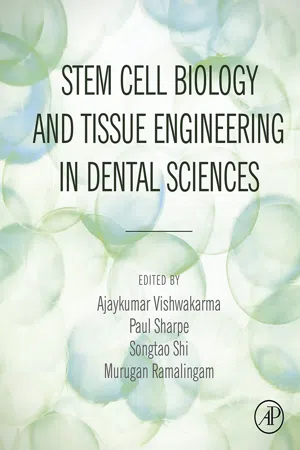
Stem Cell Biology and Tissue Engineering in Dental Sciences
Ajaykumar Vishwakarma,Paul Sharpe,Songtao Shi,Murugan Ramalingam
- 932 pagine
- English
- ePUB (disponibile sull'app)
- Disponibile su iOS e Android
Stem Cell Biology and Tissue Engineering in Dental Sciences
Ajaykumar Vishwakarma,Paul Sharpe,Songtao Shi,Murugan Ramalingam
Informazioni sul libro
Stem Cell Biology and Tissue Engineering in Dental Sciences bridges the gap left by many tissue engineering and stem cell biology titles to highlight the significance of translational research in this field in the medical sciences. It compiles basic developmental biology with keen focus on cell and matrix biology, stem cells with relevance to tissue engineering biomaterials including nanotechnology and current applications in various disciplines of dental sciences; viz., periodontology, endodontics, oral & craniofacial surgery, dental implantology, orthodontics & dentofacial orthopedics, organ engineering and transplant medicine. In addition, it covers research ethics, laws and industrial pitfalls that are of particular importance for the future production of tissue constructs.
Tissue Engineering is an interdisciplinary field of biomedical research, which combines life, engineering and materials sciences, to progress the maintenance, repair and replacement of diseased and damaged tissues. This ever-emerging area of research applies an understanding of normal tissue physiology to develop novel biomaterial, acellular and cell-based technologies for clinical and non-clinical applications. As evident in numerous medical disciplines, tissue engineering strategies are now being increasingly developed and evaluated as potential routine therapies for oral and craniofacial tissue repair and regeneration.
- Diligently covers all the aspects related to stem cell biology and tissue engineering in dental sciences: basic science, research, clinical application and commercialization
- Provides detailed descriptions of new, modern technologies, fabrication techniques employed in the fields of stem cells, biomaterials and tissue engineering research including details of latest advances in nanotechnology
- Includes a description of stem cell biology with details focused on oral and craniofacial stem cells and their potential research application throughout medicine
- Print book is available and black and white, and the ebook is in full color
Domande frequenti
Informazioni
An Introduction to Stem Cell Biology and Tissue Engineering
2 Department of Craniofacial Development and Stem Cell Biology, King´s College London, London, United Kingdom
3 Center for Craniofacial Molecular Biology, University of Southern California, Los Angeles, CA, USA
4 Institut National de la Santé Et de la Recherche Médicale UMR977, Faculté de Chirurgie Dentaire, Université de Strasbourg, Strasbourg, France
5 WPI-Advanced Institute for Materials Research (WPI-AIMR), Tohoku University, Sendai, Japan
6 Centre for Stem Cell Research (CSCR) (A unit of Institute for Stem Cell Biology and Regenerative Medicine, Bengaluru) Christian Medical College Campus, Vellore, Tamil Nadu, India
Abstract
1.1 Introduction
1.2 The Emergence of Tissue Engineering and Regenerative Medicine
Indice dei contenuti
- Cover image
- Title page
- Table of Contents
- Copyright
- List of Contributors
- Foreword
- Chapter 1: An Introduction to Stem Cell Biology and Tissue Engineering
- Part I: Developmental Biology: A Blueprint for Tissue Engineering
- Part II: In Vitro Regulation of Cell Behaviour and Tissue Development
- Part III: Biomaterials in Tissue Engineering
- Part IV: Oral and Craniofacial Stem Cells for Tissue Engineering
- Part V: Tooth Tissue Engineering
- Part VI: Tissue Engineering in Endodontics
- Part VII: Periodontal Tissue Engineering
- Part VIII: Craniofacial Tissue Engineering
- Part IX: Bioengineering Organs in Head and Neck
- Part X: Tissue Engineering Skin and Oral Mucosa
- Part XI: Tissue Engineered Implant Dentistry
- Part XII: Tissue Engineering in Orthodontics & Dentofacial Orthopedics
- Part XIII: Transplantation of Engineered Tissue Constructs
- Part XIV: Research Ethics and Law
- Glossary
- Nomenclature
- Index